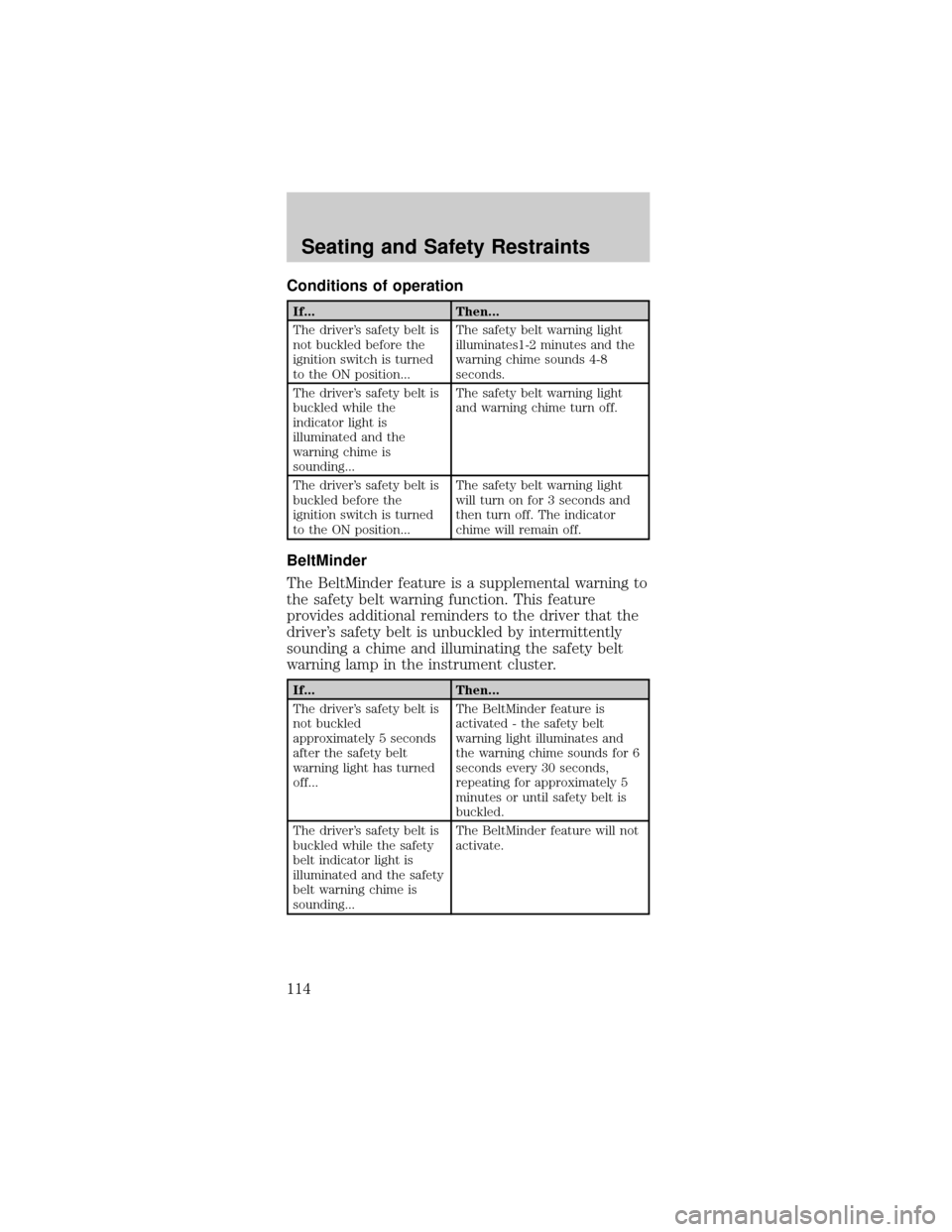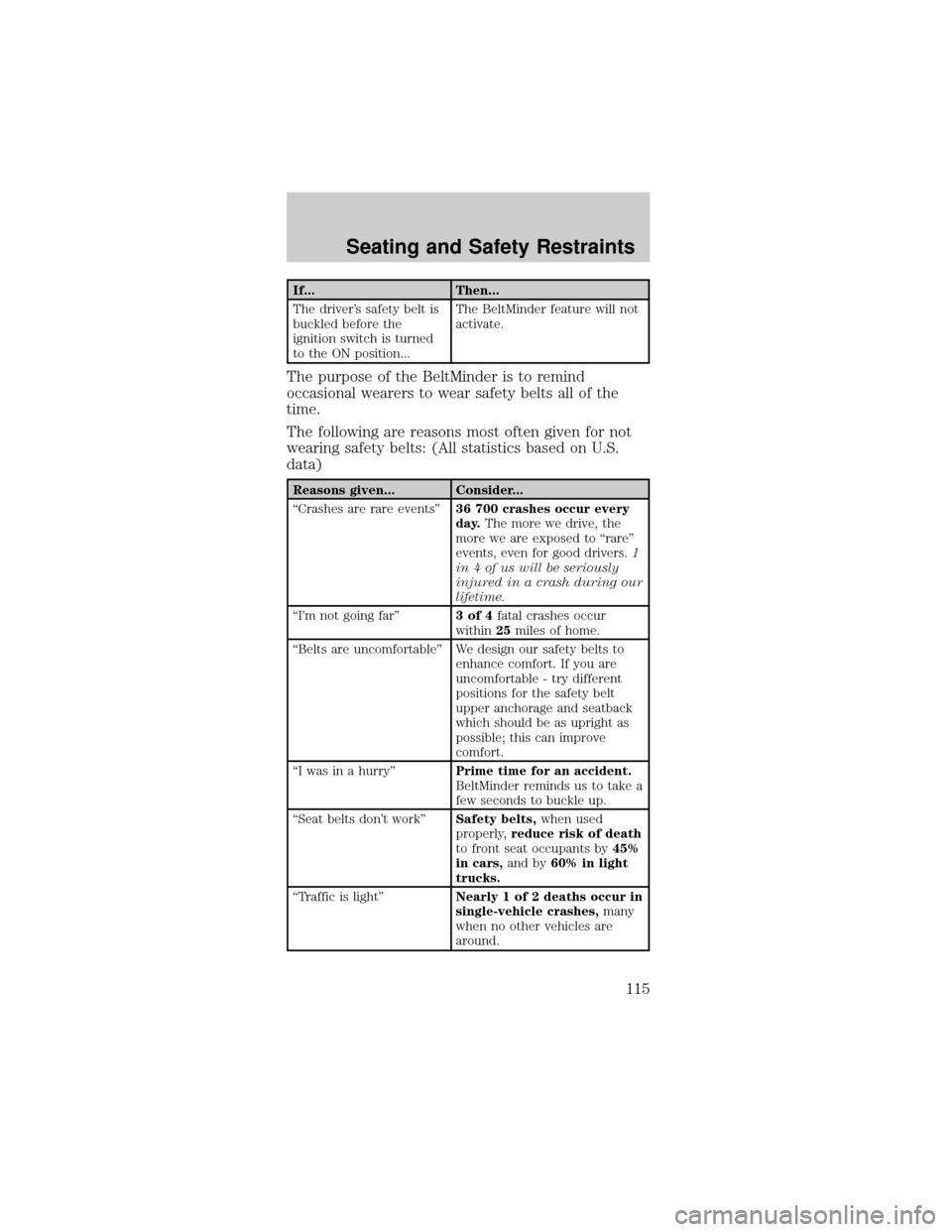Page 114 of 264

Conditions of operation
If... Then...
The driver's safety belt is
not buckled before the
ignition switch is turned
to the ON position...The safety belt warning light
illuminates1-2 minutes and the
warning chime sounds 4-8
seconds.
The driver's safety belt is
buckled while the
indicator light is
illuminated and the
warning chime is
sounding...The safety belt warning light
and warning chime turn off.
The driver's safety belt is
buckled before the
ignition switch is turned
to the ON position...The safety belt warning light
will turn on for 3 seconds and
then turn off. The indicator
chime will remain off.
BeltMinder
The BeltMinder feature is a supplemental warning to
the safety belt warning function. This feature
provides additional reminders to the driver that the
driver's safety belt is unbuckled by intermittently
sounding a chime and illuminating the safety belt
warning lamp in the instrument cluster.
If... Then...
The driver's safety belt is
not buckled
approximately 5 seconds
after the safety belt
warning light has turned
off...The BeltMinder feature is
activated - the safety belt
warning light illuminates and
the warning chime sounds for 6
seconds every 30 seconds,
repeating for approximately 5
minutes or until safety belt is
buckled.
The driver's safety belt is
buckled while the safety
belt indicator light is
illuminated and the safety
belt warning chime is
sounding...The BeltMinder feature will not
activate.
Seating and Safety Restraints
114
Page 115 of 264

If... Then...
The driver's safety belt is
buckled before the
ignition switch is turned
to the ON position...The BeltMinder feature will not
activate.
The purpose of the BeltMinder is to remind
occasional wearers to wear safety belts all of the
time.
The following are reasons most often given for not
wearing safety belts: (All statistics based on U.S.
data)
Reasons given... Consider...
ªCrashes are rare eventsº36 700 crashes occur every
day.The more we drive, the
more we are exposed to ªrareº
events, even for good drivers.1
in 4 of us will be seriously
injured in a crash during our
lifetime.
ªI'm not going farº3of4fatal crashes occur
within25miles of home.
ªBelts are uncomfortableº We design our safety belts to
enhance comfort. If you are
uncomfortable - try different
positions for the safety belt
upper anchorage and seatback
which should be as upright as
possible; this can improve
comfort.
ªI was in a hurryºPrime time for an accident.
BeltMinder reminds us to take a
few seconds to buckle up.
ªSeat belts don't workºSafety belts,when used
properly,reduce risk of death
to front seat occupants by45%
in cars,and by60% in light
trucks.
ªTraffic is lightºNearly 1 of 2 deaths occur in
single-vehicle crashes,many
when no other vehicles are
around.
Seating and Safety Restraints
115
Page 117 of 264

The BeltMinder feature can be deactivated/activated
by performing the following procedure:
Before following the procedure, make sure that:
²The parking brake is set.
²The gearshift is in P (Park) (automatic
transmission) or the neutral position (manual
transmission).
²The ignition switch is in the OFF position.
²All vehicle doors are closed.
²The driver's safety belt is unbuckled.
²The parklamps/headlamps are in OFF position (If
vehicle is equipped with Autolamps, this will not
affect the procedure).
To reduce the risk of injury, do not
deactivate/activate the Belt Minder feature
while driving the vehicle.
1. Turn the ignition switch to the RUN (or ON)
position. (DO NOT START THE ENGINE.)
2. Wait until the safety belt warning light turns off.
(Approximately 1±2 minutes.)
²Steps 3±5 must be completed within 60 seconds
or the procedure will have to be repeated.
3. Buckle then unbuckle the safety belt three times,
ending with the safety belt unbuckled. This can be
done before or during BeltMinder warning activation.
4. Turn on the parklamps/headlamps, turn off the
parklamps/headlamps.
5. Buckle then unbuckle the safety belt three times,
ending with the safety belt unbuckled.
²After step 5 the safety belt warning light will be
turned on for three seconds.
6. Within seven seconds of the safety belt warning
light turning off, buckle then unbuckle the safety
belt.
Seating and Safety Restraints
117
Page 118 of 264

²This will disable BeltMinder if it is currently
enabled, or enable BeltMinder if it is currently
disabled.
7. Confirmation of disabling BeltMinder is provided
by the safety belt warning light flashing four times
per second for three seconds.
8. Confirmation of enabling BeltMinder is provided
by:
²The safety belt warning light flashing four times
per second for three seconds.
²Followed by three seconds with the safety belt
warning light off.
²Once again, the safety belt warning light will flash
four times per second for three seconds.
9. After receiving confirmation, the
deactivation/activation procedure is complete.
Safety belt extension assembly
If the safety belt is too short when fully extended,
there is a 20 cm (8 inch) safety belt extension
assembly that can be added (part number 611C22).
This assembly can be obtained from your dealer at
no cost.
Use only extensions manufactured by the same
supplier as the safety belt. Manufacturer
identification is located at the end of the webbing on
the label. Also, use the safety belt extension only if
the safety belt is too short for you when fully
extended. Do not use extensions to change the fit of
the shoulder belt across the torso.
Seating and Safety Restraints
118
Page 122 of 264
Steps you can take to properly position yourself
away from the air bag:
²Move your seat to the rear as far as you can while
still reaching the pedals comfortably.
²Recline the seat slightly (one or two degrees)
from the upright position.
Do not put anything on or over the air bag
module. Placing objects on or over the air
bag inflation area may cause those objects to be
propelled by the air bag into your face and torso
causing serious injury.
Do not attempt to service, repair, or modify
the air bag supplemental restraint systems
or its fuses. See your Ford or Lincoln Mercury
dealer.
Modifications to the front end of the vehicle,
including frame, bumper, front end body
structure and tow hooks may affect the
performance of the air bag sensors increasing the
risk of injury. Do not modify the front end of the
vehicle.
Seating and Safety Restraints
122
Page 124 of 264

not rollover, side-impact, or rear-impacts unless the
collision causes sufficient longitudinal deceleration.
The air bags inflate and
deflate rapidly upon
activation. After air bag
deployment, it is
normal to notice a
smoke-like, powdery
residue or smell the
burnt propellant. This
may consist of
cornstarch, talcum
powder (to lubricate
the bag) or sodium
compounds (e.g., baking soda) that result from the
combustion process that inflates the air bag. Small
amounts of sodium hydroxide may be present which
may irritate the skin and eyes, but none of the
residue is toxic.
While the system is designed to help reduce serious
injuries, contact with a deploying air bag may also
cause abrasions, swelling or temporary hearing loss.
Because air bags must inflate rapidly and with
considerable force, there is the risk of death or
serious injuries such as fractures, facial and eye
injuries or internal injuries, particularly to occupants
who are not properly restrained or are otherwise out
of position at the time of air bag deployment. Thus,
it is extremely important that occupants be properly
restrained as far away from the air bag module as
possible while maintaining vehicle control.
The SRS consists of:
²driver and passenger air bag modules (which
include the inflators and air bags)
²one or more impact and safing sensors
²a readiness light and tone
²a diagnostic module
²and the electrical wiring which connects the
components
Seating and Safety Restraints
124
Page 125 of 264

The diagnostic module monitors its own internal
circuits and the supplemental air bag electrical
system warning (including the impact sensors), the
system wiring, the air bag system readiness light, the
air bag back up power and the air bag ignitors.
Several air bag system components get hot
after inflation. Do not touch them after
inflation.
If the air bag has deployed,the air bag will
not function again and must be replaced
immediately.If the air bag is not replaced, the
unrepaired area will increase the risk of injury in a
collision.
Determining if the system is operational
The SRS uses a readiness light in the instrument
cluster or a tone to indicate the condition of the
system. Refer toAir bag readinesssection in the
Instrument clusterchapter. Routine maintenance of
the air bag is not required.
A difficulty with the system is indicated by one or
more of the following:
²The readiness light
will either flash or
stay lit.
²The readiness light will not illuminate immediately
after ignition is turned on.
²A series of five beeps will be heard. The tone
pattern will repeat periodically until the problem
and/or light are repaired.
If any of these things happen, even intermittently,
have the SRS serviced at your dealership or by a
qualified technician immediately. Unless serviced,
the system may not function properly in the event of
a collision.
AIR
BAG
Seating and Safety Restraints
125
Page 136 of 264

STARTING
Positions of the ignition
1. ACCESSORY, allows
the electrical
accessories such as the
radio to operate while
the engine is not
running. For manual
transmission, you must
depress the ignition
release lever.
2. LOCK, locks the steering wheel, automatic
transmission gearshift lever and allows key removal.
For manual transmission, you must depress the
ignition release lever.
3. OFF, shuts off the engine and all accessories
without locking the steering wheel. This position
also allows the automatic transmission shift lever to
be moved from the P (Park) position without the
brake pedal being depressed.
4. ON, all electrical circuits operational. Warning
lights illuminated. Key position when driving.
5. START, cranks the engine. Release the key as
soon as the engine starts.
Preparing to start your vehicle
Engine starting is controlled by the powertrain
control system. This system meets all Canadian
Interference-Causing Equipment standard
requirements regulating the impulse electrical field
strength of radio noise.
When starting a fuel-injected engine, avoid pressing
the accelerator before or during starting. Only use
the accelerator when you have difficulty starting the
engine. For more information on starting the vehicle,
refer toStarting the enginein this chapter.
3
1
2
5
4
Driving
136